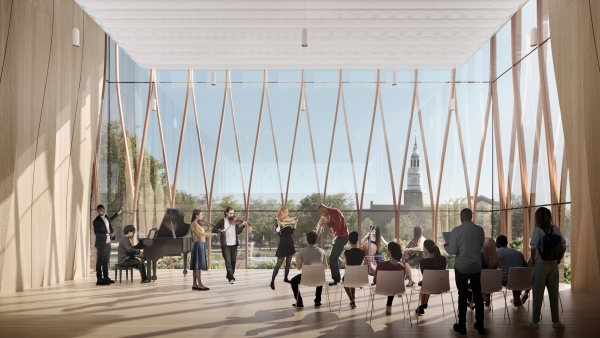

What is the timeline for the construction and reopening of the Hop?
Construction began in November 2023 and you can follow the progress on the Hop Project Happenings page. The new Hop will open to students and faculty in September, 2025 with various events and activities to warm up the building and new venues throughout the fall. Opening weekend for the public is October 16-19. Full public programming will begin in January 2026.
What is the vision for the new Hopkins Center?
The Hopkins Center will increase its capacity to serve as a vital hub for artistic experiences at Dartmouth, uniting diverse art forms under one roof as it has since its opening in 1962. Every element of the design reflects the core principles of welcoming, gathering, and creating, as foundational to the strategic vision for the Hop's building and program as well as the Arts District more broadly.
As an essential component of the Dartmouth liberal arts experience, the arts produce curious, creative, empathetic human beings. The revitalized Hop will advance Dartmouth's mission and enhance opportunities for artistic exploration and growth, inspiring students, faculty, staff, alumni, and welcoming visitors from across New England and beyond.
- create spaces that inspire a sense of welcome, allow for social and artistic gathering, and support our resident artists, students, and faculty in creating.
- make the arts central to the liberal arts experience and anchor the vibrant Dartmouth Arts District
- forge interdisciplinary connections and support the development of ambitious work
- meet the growing need for student learning and expression in the arts
- and expand the Hop's position as a cultural center in the region
What is the scope of the Hop project?
The project includes a 15,000-square-foot expansion, named the Daryl and Steven Roth Wing, which is the new and central point of entry to the Hopkins Center and features a state-of-the-art recital hall, a versatile black box theater, the Hop's first dedicated dance studio, and an accessible, welcoming, landscaped plaza and entrance forum. The Roth Wing complements the Hop's original architecture by Harrison and Abramovitz, maintaining key building components such as the iconic arches, the beloved Top of the Hop, Moore Theater, Spaulding Auditorium, and Warner Bentley Theater. The project also transforms an additional 55,000 square feet of existing space within the building.
What are the key design elements?
Explore the new and redesigned spaces.
What is the Dartmouth Arts District?
Dartmouth and the community of alumni and donors have invested over $180 million in the Dartmouth Arts District, which the new Hop anchors. It includes the Hood Museum of Art, redesigned by Tod Williams and Billie Tsien Architects in 2019 and the Black Family Visual Arts Center, completed in 2012 by Machado Silvetti, and the academic arts departments.
How is the project being funded?
The re-imagining of the Hop marks a new milestone in Dartmouth's decade-long, $190 million investment in its Arts District, and is also part of College's eight-year, more than $3 billion "The Call to Lead" campaign, which aims to dramatically expand experiential learning opportunities within Dartmouth's liberal arts educational model. The Hop Project is primarily funded through private philanthropy, with a lead donation of $25 million from Daryl and Steven Roth '62, Tuck '63.
Who is the architect and how were they selected?
The project is being led by the New York office of the renowned design practice Snøhetta. Dartmouth selected Snøhetta because of their extensive experience in honoring historic architecture and seamlessly merging it with forward-looking design. Its expertise in creating dynamic relationships between interior and exterior spaces and with existing built and natural landscapes was equally important to the decision.
A selection committee comprised of Dartmouth leadership from across the campus invited 15 architectural firms to submit proposals for the Hopkins Center project. From those that responded, three were selected to submit detailed proposals. Snøhetta—with their strong sense of collaboration and broad experience designing inviting cultural spaces—was awarded the project.
Is accessibility being improved as part of the project?
Yes, the project will improve interior and exterior accessibility in both new and existing spaces for visitors and artists alike.
How does sustainability factor into the project?
As part of President Philip J. Hanlon's '77 sustainability and efficiency goals, there is a Dartmouth Sustainable Energy Project underway throughout the campus. Sustainability is a key aspect of the Hop project, which includes the following sustainability strategies:
- eliminate steam units from the building and replace with highly efficient air handling units, which will reduce energy use intensity and carbon emissions
- reuse existing building materials, and use sustainable materials, including local and Forest Stewardship Council (FSC)-certified materials with low VOCs
- use energy-efficient LED lighting, including smart lighting systems with occupancy and vacancy sensors
How can I stay informed?
Join the Hop mailing list and Subscribe to Dartmouth News.
Who can I contact regarding my questions about the Hop project?
We'd love to hear your thoughts. Please email Hop leadership at hopkins.center@dartmouth.edu.